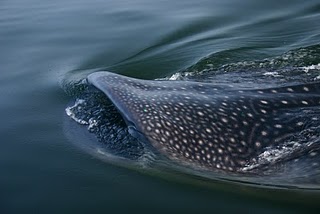Implications of the first sighting of whale sharks in the gulf oil slick
 Friday, July 2, 2010 at 11:37AM
Friday, July 2, 2010 at 11:37AM I recently experienced a moment of genuine dread regarding the oil spill in the Gulf of Mexico, and it was neither a familiar nor comfortable feeling. What is it that invoked such a powerful feeling after a disaster that has been underway for the last 80-odd days, now? Something that struck a little close to home, of course: the first direct impact to whale sharks. You may have seen this story coming across the wires over the past two days about NOAA scientists who, while on an aerial survey of the impacted area, observed 3 whale sharks swimming among ribbons of surface oil, not 4 miles from the epicenter of the Deepwater Horizon spill. This observation has serious implications; let me explain.
Whale sharks are widely-ranging tropical migratory sharks that are unusual among their more toothy relatives in that they eat plankton. Two of the adaptations they use to pursue this lifestyle – surface filter feeding and an exquisite sense of smell – make them especially susceptible to the impacts of the oil spill. I had all but convinced myself (perhaps wishfully thinking) that whale sharks would be able to sense the altered chemistry of the affected water bodies and avoid the area. It now seems that this is not the case; the observation by the NOAA scientists suggest that either whale sharks cannot tell the difference between polluted and unpolluted water, or they can tell the difference but do not alter their behaviour in such a way as to avoid the ribbons and plumes. As USM researcher Eric Hoffmayer states in the article, this is the realization of the worst fears of whale shark scientists, and I count myself among those.How can it be that whale sharks are unable to tell the difference if their sense of smell is so good? One simple explanation is that the olfactory abilities may be extremely selective. Scientists don’t know exactly what sort of chemicals whale sharks are homing in on when they seek out patches of food in the ocean – indeed, addressing this question is one of the goals of this year’s whale shark research program at Georgia Aquarium – but we have some good candidate molecules. If the whale shark sense of smell is highly tuned to these compounds and relatively insensitive to other families of chemicals, like hydrocarbons (oil and gas), then it’s certainly possible that whale sharks simply cannot detect the problem.
If whale sharks are swimming into oil-polluted waters and fouling their filters with oil, what does that mean? In my best estimation, it means that the oil spill represents an extremely serious threat to whale shark health. I am by no means the first person to suggest this. Nature identified whale sharks as one of the 5 species most likely to be affected by the oil spill, and other scientists like Bob Hueter from Mote Marine Laboratory have also highlighted the risks. The true toll that the spill exacts on the Gulf of Mexico whale shark population will not be known for some time, but the thought of dead or dying whale sharks sinking silently into the depths (dead sharks generally sink, not float) is yet more motivation to put an end to the spill and to undertake immediate and extensive research and conservation programs to assess the damage and plan a road to recovery for the whale sharks – and all the other affected wildlife – in the Gulf of Mexico.
 1 Comment |
1 Comment |  Email Article | tagged
Email Article | tagged  Gulf of Mexico,
Gulf of Mexico,  NOAA,
NOAA,  elasmobranch,
elasmobranch,  oil,
oil,  pelagic,
pelagic,  pollution,
pollution,  sharks,
sharks,  whale sharks
whale sharks 




Reader Comments (1)
This is sad, sad news. Whale sharks and all of these animals in the ocean are magnificent. Not enough people realize or care. For days after this disaster I wondered if the animals would leave the area. It is apparent now that they aren't. Almost seems some are being attracted to it. Is there any possible way to distract them from the area, safely?